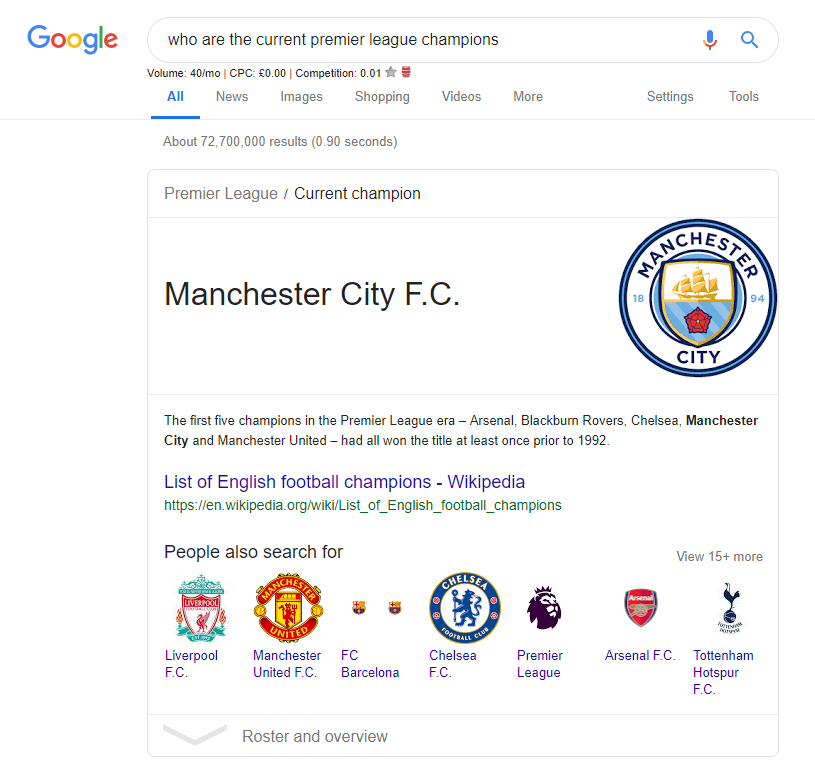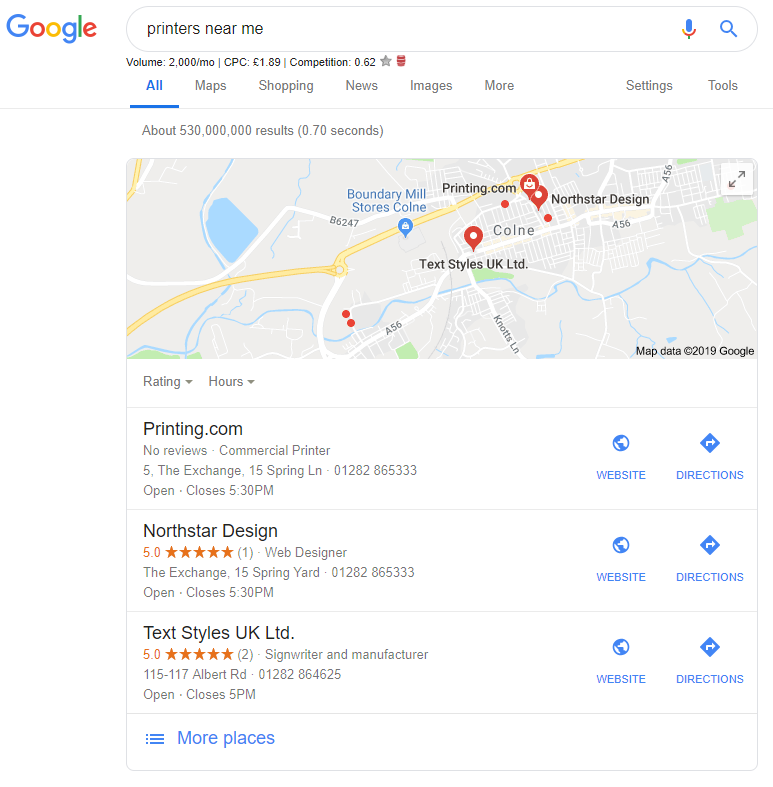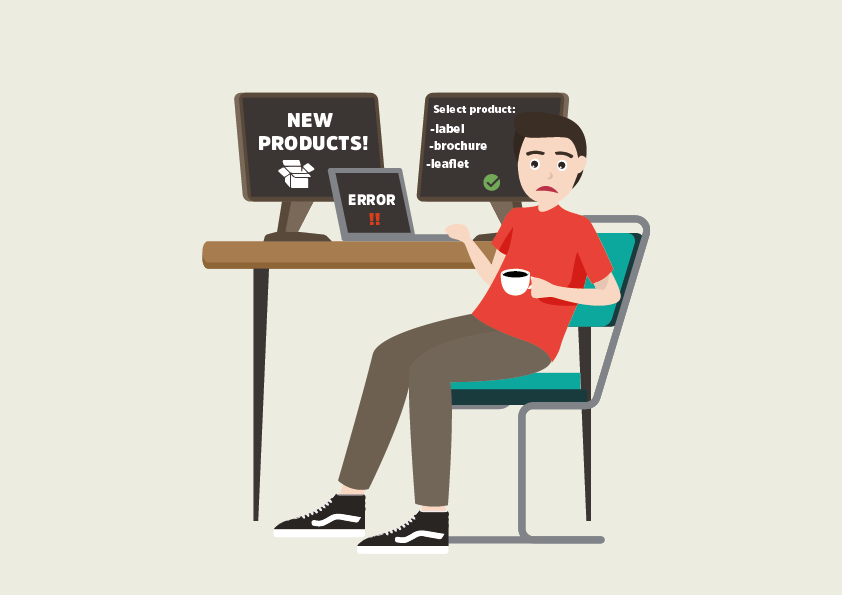The Most Important Marketing Technique that Printing Companies are Neglecting
Despite its growing importance, local search is often a neglected area for most businesses but, it's a technique that printing companies need to embrace. 2019 is set to be as important as ever for local search and if print firms aren't already utilizing it, they will miss out on the many benefits it can bring.
Here's why Local Search Marketing needs your attention...
According to Google, 50% of people who conduct a local search on their smartphone will visit a store within a day. A recent survey carried out by Moz suggests that local businesses are going to need a website more than ever in 2019; 1,411 people were surveyed and 64% of those agreed that Google was becoming the new homepage for local businesses.
It used to be the case that a search with local intent brought up a list of ten nearby businesses which included links through to the business' website, but more recently, there has been a number of ads starting to creep into this group of local listings. There was also a reduction from ten to seven listings and more recently this has been further reduced to only three listings. One other thing of note is that there’s been an increase in the amount of Google-owned interfaces which means that, as Rand Fishkin (formerly of Moz and now of SparkToro) pointed out, there are more 'zero click searches' happening on Google than ever before. This shows that the battle to get your business noticed, outside of having an ad budget, is getting more and more difficult, especially for local businesses.

Zero click search example from Google.co.uk. The links below the club crests don't even link through to the club's websites, they take you through to another Google search. just another example of how Google are making things difficult.
So, hopefully you're now convinced that this is something you need to implement, so let's take a look at a few of the techniques that will help you make the most of local search marketing in 2019.
Mobile, Mobile, Mobile!
Did I mention mobile? Right... As was mentioned above, half of people who conduct a local search on their phone will visit a store within a day of making that search. This on its own should be reason enough for you to take note and start to make more of an effort with your local search presence but, in case it isn't, here's some more interesting facts and figures about the growth of mobile in recent times.
Consumers now spend more than five hours a day on their phones and a study from AdWeek found that time spent watching videos on phones has grown by 88% year over year. With this in mind, it's no surprise that in 2018, 52.2% of all global traffic was generated through mobile phones and 57% of all U.S. online traffic now comes from smartphones and tablets. Google knows this (obvs) and have made changes to their search algorithm by introducing the mobile first index.
With this, Google will predominantly use the mobile version of any content that they index and rank in the search engine. This is due to the sheer number of people around the world consuming content on their phones so by indexing the mobile version, they are ensuring that the majority of people around the world are being served the best content and thus are having the best experience that they possibly can on their devices.
A Website is your Lifeblood
According to a 2017 CNBC survey, 45% of small businesses have no website, and of course, most local businesses are small businesses so yeah, we're looking at you, local print firm in *insert local village/town/city*. Yes, it's clear from what we've already looked at that it's becoming harder to rank your website in the way of zero click searches that Google seems to favour but, they've not stripped small, local businesses of all options. There is still the local pack listings that you should be taking advantage of.

Example of the Google 'Local Pack Listings' from Google.co.uk for the search term "printers near me"
Another Moz survey shows that 75% of the top 3 Google local pack listings have a website ranking on page 1. So, if you don't have a website then you're not really going to stand much of a chance of ever appearing here. If you do have a website but it's not up to much then you're in a slightly better position but you need to understand that this is your key to improving locally - look after your website and it *should* look after you. In case you're not entirely sure how you can best look after your website, here's a few little tips for you:
1. Publish Relevant Content
This is arguably the easiest thing that any webmaster can do to improve the quality and relevance of their website. Publishing content relevant to your audience (your customers) will not only tell them in no uncertain terms what you and your company do and what you're all about but it's also good for Google. You may need to learn a little bit about keyword research but if you can figure this out, you should start to be able to write relevant content that will help you to rank in the search engines for your chosen keywords.
2. Videos
Video content has been around for years and years and the future of video marketing is something that is perpetually written about but, it's important and 2019 is going to be as big as ever for video. 64% of customers are more likely to make a purchase online after watching a video about it and, this one's a big one, 59% of company decision makers would rather watch a video than read an article or a blog post. If this isn't enough to convince you to start taking video content seriously, then I don't even know anymore. 🤷
3. Research
We briefly mentioned it above but, one other thing that should be considered when/if you do start producing content is keyword research. Equally as important though is researching your customers' needs and wants. Converse and get involved with your customers and find out what they want to know and what they're interested in. You can then reflect on your website what exactly it is that your customers are looking for from you and target them better with more relevant content.
Absolutely key in all of this though: don't get caught up in old school SEO practices. If you do read content about keyword research, beware of old articles. SEO and digital marketing are constantly changing landscapes and things quickly become outdated and old so try and read the most recent copy that you can when it comes to advice. One thing that you should be doing when you write copy for all element of your site (title tags, page headlines, text and so on) is to ensure that human language is clear. Don't try to target specific, exact keywords with things like "printing company in specific location". It's old, it's been done to death. Google is much smarter these days and will know what a page is about if you structure it properly, use human language and keep the copy relevant to your topic.
What Now?
Well, from this there's plenty that you can take away and lots that you can implement in order to make the most of local search and your website.
Mobile Optimization
Ensuring your website is fully optimized for mobile is paramount. With the mobile first index being introduced, as we mentioned above, without mobile you will struggle to rank well anywhere. Also, important to consider is usability, or the user experience (UX) that someone will have when they visit your website. Ensuring things like 'hamburger menus' or 'accordions' are in use is a good place to start as it means that the menu on your site won't be in the way and is easily accessible should someone need to navigate to a different page.
Content is King
Or so the saying goes... That's a conversation for another time but, ensuring that you write excellent, relevant content for your site is also vital. Keep in mind that the copy on your site should also be mobile-friendly. If you're not quite sure what this means, try to keep to short sentences and compact paragraphs. Ensure the font on the mobile version of your site is large and readable on any sized mobile screen, from tablet to mobile.
Produce Videos
Any content that you can create for your site as a video, do it. Potential customers much prefer to consume a video than to read a blog post and roughly 75 million people in the US consume videos online every day. That's just under a quarter of the US population. Add to that the fact that nearly 50% of all video is watched on a mobile device and you can see how this is vitally important.
One final point on this is that according to Cisco, online video will account for 80% of all web traffic by this year, 2019. If you're not ready for this, you'll only end up being left behind.
Your Customers
Last but by no means least, your customer's wants and needs are absolutely paramount. Look at their behaviour on your site using tools like HotJar and analyze what they're doing, how they're using your site and how they're taking in the content on your site. We have implemented HotJar here at Tharstern so that we can see how users navigate the site, the places that they do and don't click on certain pages and many other things that enable us to better develop the site in the future based off data and what our users don't interact with or absolutely love. Here's a screen grab of one of our old heat maps from HotJar which shows where people have clicked the most on the 'above the fold' section of our homepage.

Utilizing tools like this will mean you can identify areas that need improvement on your site. If your main call-to-action, such as an inquiry button, isn't getting clicked as much as you had hoped, you can analyze how it's being used and make changes where needed in order to deliver the best experience you can.
Also, one other thing to consider but again, this is a whole new blog post in itself, is voice search. A lot of your customers these days will be using things like Google Home or Amazon Alexa to find their local print shop and you need to be ready to be there when they're searching because the usage of smart speakers in the home is only going to increase from the already 24% of US households that currently have a smart speaker.
Share this
You May Also Like
These Related Stories

How product diversification makes you less efficient and how to fix it

Systemizing your print business part 1 - An introduction to Systemization
